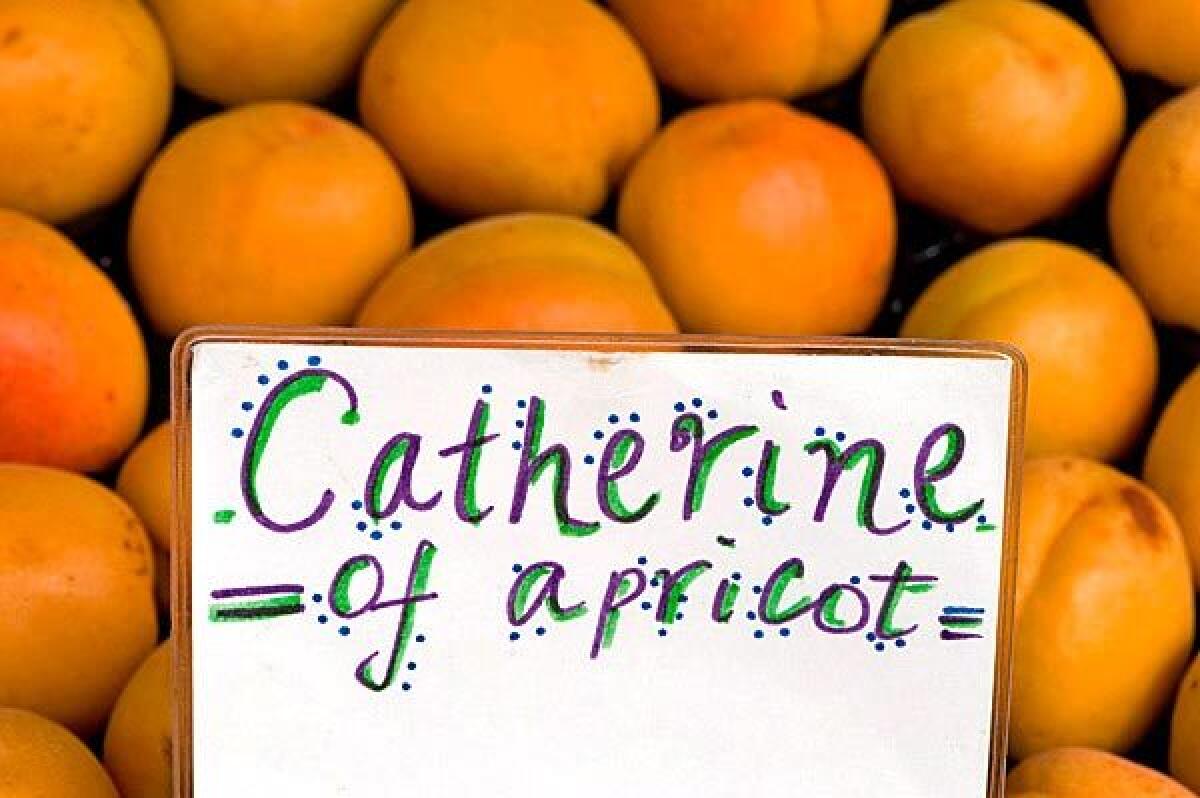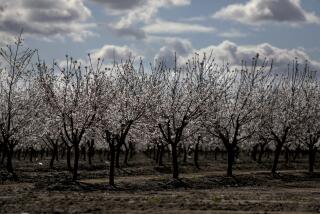Fruit varietals: Identity crisis in the produce aisle

There are 230 varieties of peaches grown in California, freestone and clingstone, heirloom and newly developed, flavorful and bland, but when you go to the grocery store and even many farmers markets, they’re usually sold just as “peaches.”
The identification of a fruit’s variety is the single most important piece of information consumers have in deciding what it will taste like and whether to buy, but the era in which consumers could look for distinctive varieties by name — Fantasia nectarine, O’Henry peach, Santa Rosa plum — is rapidly passing.
Aside from apples and pears, most fruits are typically not identified by variety at markets, and have not been for years. This is a problem not just for fruit connoisseurs but also for all consumers. To give just one example, buyers often have no way to distinguish between yellow peaches with a traditional balance of sweetness and acidity and the low-acid varieties; the latter may be preferred by some for eating out of hand, but they are virtually useless for cooking.
Until 2006, the California Tree Fruit Agreement, the organization that sets standards for the state’s shippers of peaches, nectarines and plums, required the specific variety to be identified on the carton. But some growers and shippers found that they could not readily market certain varieties perceived by buyers as inferior, and so the CTFA now allows fruit to be shipped under generic designations such as “yellow peach.” Dale Janzen, the organization’s director of industry relations, estimates that only 30% of shipments today name the variety on the carton.
There was a time when many of the stone fruit varieties grown around the nation had long lives and distinctive identities. In recent decades, however, the interval between stone fruit variety generations has contracted to just 20 years, or even 10, after which growers replace their trees with newer varieties. Plus, supermarket produce managers, who now mostly have little in-depth knowledge of fruit, don’t want to be bothered segregating batches by name.
Variety names could easily be printed on produce stickers, which instead have recently been filled with bar codes; this may be convenient for self-checkout, but it gives a creepy industrial feel to the product.
For many fruit varieties, the true cultivar name, such as Cripps Pink apple, has been overshadowed by the same variety’s marketing name, the Pink Lady. Part of the reason is that patent protection of fruit varieties extends for only 17 to 20 years, but names used for marketing are protected indefinitely under trademark law.
Moreover, large growers and marketers are increasingly moving to a system that subsumes individual varieties in a series of cultivars that are marketed under the same name. For example, Sun World has a line of plums of different varieties that all share purple-black skin and red flesh and are all marketed as Black Diamonds, from May to October.
This commercial nomenclature is convenient for marketers, but something has also been lost — the feedback mechanism that allows consumers to identify varieties that they like, and ask for them by name.
Both philosophically and practically, it’s crucial to capitalism that good products be rewarded with increased demand and higher prices, and inferior ones fall by the wayside. When a named variety delights consumers, they buy more, even if they have to wait until the following year; the produce manager orders more from the wholesaler, who increases his order from the grower, who buys more trees from the nursery, who pays greater royalties to the breeder for devising the variety to begin with and is encouraged to come up with more such superior fruit.
Conversely, when inferior varieties are marketed generically, producers of inferior varieties piggyback on producers of better varieties. In a pomological version of Gresham’s law, bad fruit drives out good.
So why don’t marketers sell by variety? All too often today, new varieties are bred to appeal to the lowest common denominator, to be inoffensive to the greatest number of people, so it suits the industrial distribution system when fruit is marketed anonymously. When fruit quality is homogenized, variety is less significant; in turn, anonymity deprives consumers of their main weapon to resist homogenization.
It doesn’t have to be so. The European Community requires that grapes, oranges, apples and pears be identified by variety at the point of sale, and the practice is common there for other fruits too. There’s no reason why American retailers should not respect consumers by empowering them to select by variety.
There is a downside to varietal transparency, however: When shoppers become smitten with a superior variety, such as the Tulameen raspberry, they may demand it to the exclusion of others, even early or late in its season, when other varieties would actually taste better, notes Chad Finn, a berry breeder with the U.S. Department of Agriculture. It can be difficult for consumers to make a fully informed decision, juggling the typical season for a variety, the geographical area where a batch is grown, the earliness or lateness of crops that year, etc.
Growers and marketers don’t want consumers to get too attached to a variety by name, particularly for stone fruit varieties, which are often in season for just a week or two, before a new variety takes its place. Similarly, they want to be free to replace obsolete varieties in the orchard and store, without consumers saying, “Oh, you don’t have Fantasia nectarines anymore, phooey on you.”
You’d think that farmers markets, celebrated for keeping alive unusual produce varieties, would offer a different dynamic, but all too often when vendors are asked for the name of the fruit they’re displaying, they just say something like “white peach.” Duh! Occasionally, the farmer may not know the variety of an item because the trees were unnamed when he bought the farm, but more often the vendor is an employee who is uninvolved in farming or who can’t be bothered to list varieties.
Fitzgerald Kelly, a highly regarded vendor at the Santa Monica farmers market, takes an idiosyncratic approach to stone fruit nomenclature, bestowing his own whimsical monikers on series of similar varieties, such as Carmen Miranda for low-acid yellow-fleshed nectarines. In some cases, he offers experimental selections from breeders and doesn’t want to tip off competitors to what he’s growing; for all except old-fashioned high-acid varieties, customers don’t care to know the specific name, he says.
Another high-quality grower, John Hurley, has sometimes sold intensely flavorful, hard-to-grow Snow Queen white nectarines (in season now) as generic white nectarines, which is like mixing Ferraris and Yugos. When I pointed this out, he said, “Oh, you’re right, but I’m so exhausted by harvest and driving down here that I often lose track of the varieties.”
The culture is much different at upscale markets in the Bay Area, such as the Ferry Plaza and Berkeley markets, where most vendors make a point of identifying varieties — not because regulations require them to do so, but because it is seen as a shrewd marketing move.
Varietal identification is also indispensable to farmers market integrity. A small but increasing minority of vendors are obtaining certified production certificates that state the number of trees they’re growing but without naming specific varieties, making it much easier for those who are dishonest to buy or supplement their offerings with little fear of being caught.
What can be done to reverse the trend to anonymity, to return to a model in which fruits have names and people know and care about them? Here are three proposals.
Consumers can ask store managers and farmers market vendors to name produce varieties. You don’t have to boycott anonymous fruit, just favor vendors who do identify varieties.
Growers, packers and shippers should retract the veil of anonymity. In the long term, it’s to their economic advantage if consumers are informed and have a choice. The cost is nugatory, and a satisfied customer is likely to buy more.
Finally, fruit industry leaders, regulators and politicians can pass and enforce regulations that require produce to be identified by variety at markets. That’s not so far-fetched, since a similar law went into effect last year requiring stores to identify the country where produce was grown.
Then we can finally let the best fruit win, and when it does, we’ll know how to ask for it.
More to Read
Eat your way across L.A.
Get our weekly Tasting Notes newsletter for reviews, news and more.
You may occasionally receive promotional content from the Los Angeles Times.






